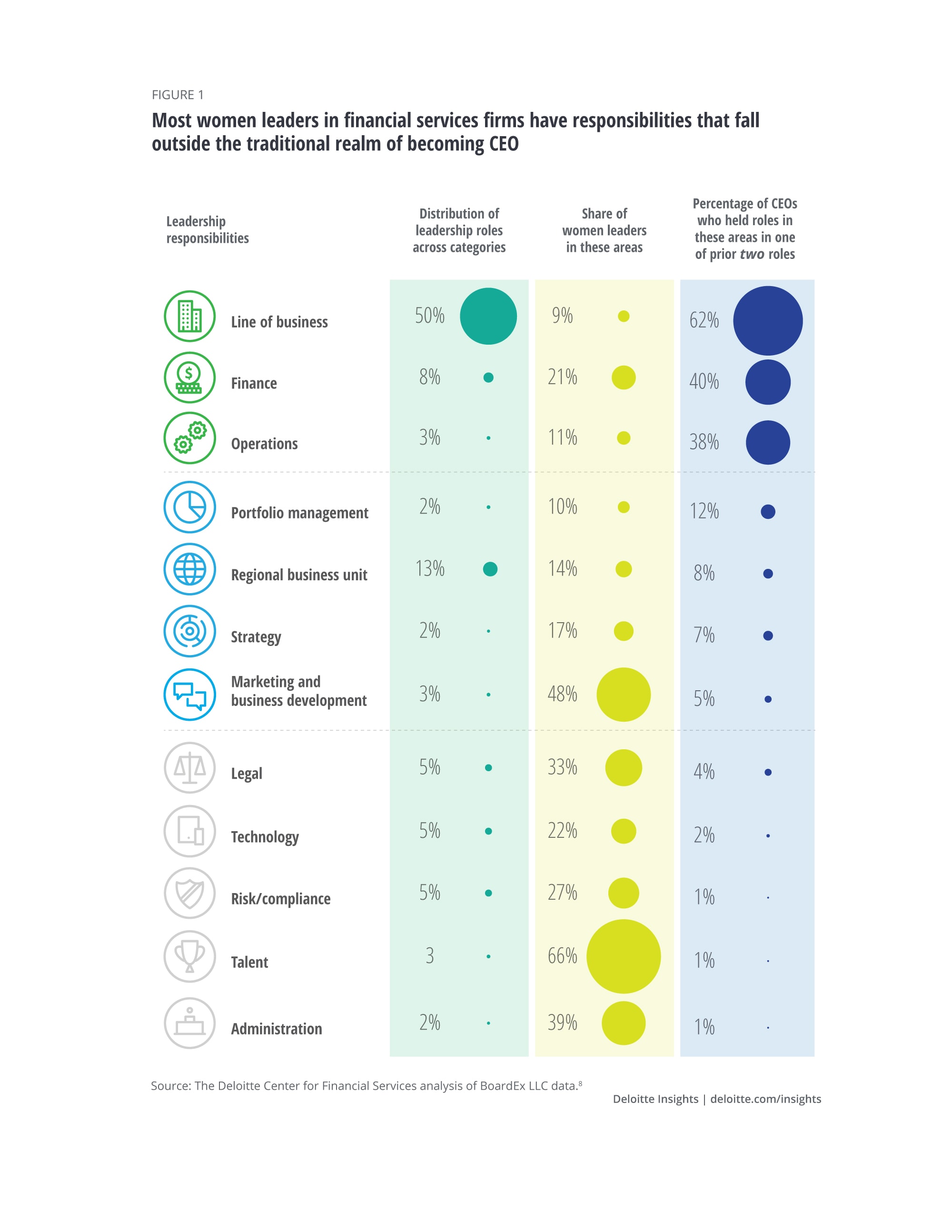
Diversifying the path to CEO in financial services How prioritizing gender diversity and inclusion in leadership development and succession planning could improve outcomes
11 minute read
13 July 2020
More women hold C-level roles in FSI firms than ever before, but relatively few have risen to become CEO. Our research shows the biggest barrier may have to do with the paths to get there.
Dear colleagues,
Financial services leaders, like those at most companies, are grappling with unprecedented challenges brought on by the COVID-19 outbreak—taking care of clients, employees, and intermediaries while maintaining business continuity. At the same time, many may still be addressing organizational challenges that arose well before the outbreak. One such issue is how to create greater gender diversity and inclusion throughout their companies and among leadership, including the consideration of candidates for the C-suite.
This report, the third in our Within Reach series on women in financial services, examines the path to chief executive officer (CEO) at the 107 biggest public US financial services companies (by asset size), as well as where women are currently situated in leadership.
Among our main findings are the following:
Key messages
The business case for D&I initiatives is clear
To a growing number of board members and leadership teams at financial services companies, the business case demonstrating how diversity and inclusion (D&I) programs can improve results, provide different perspectives, and better connect with a more diverse customer base and workforce has been made. More and more companies are realizing that diversity can drive innovation1 and increase productivity companywide.2 Gender diversity at the leadership level may also boost profitability.3
Learn more
Explore the full Within reach? collection
Learn about Deloitte’s services
Go straight to smart. Get the Deloitte Insights app.
Many US banks, insurers, investment management firms, and commercial real estate companies are examining how to increase gender D&I in their C-suite and senior leadership ranks. Yet, as of 2019, among the 107 largest public financial institutions in the United States, only six had female CEOs.4
Financial services firms seeking more diversity in their candidate pool will likely need to recruit and develop more women in the areas in which CEOs have historically come from—lines of business, finance, and operations. This can be part of a company’s comprehensive effort to achieve greater gender diversity in leadership and throughout the organization to better reflect their workforce, customer base, and society as a whole. It will likely require some significant changes in culture, talent development, and succession planning.
At the same time, companies could also reconsider what it takes to become a CEO, and how a more diverse pool of candidates—not just by gender but also background and capabilities—might benefit their competitiveness and profitability over the long term.
In addition, recruiting more women in high profile C-suite positions traditionally leading to CEO consideration might, in and of itself, help enhance diversity down the line. Our research for this series revealed a powerful multiplier effect: Each woman added to the C-suite of financial services firms resulted in a three-fold increase of women in senior leadership positions at these companies.5
In this report, we dive deeper into the types of responsibilities and roles that historically have led to CEO appointments and document the statistical underrepresentation of women in those areas. We also spotlight the leadership6 roles that women tend to hold. While these are all worthy and important roles, they do not appear to align with the traditional path if one’s ultimate goal is to be considered for the CEO job.
The path to CEO is narrow
All but six of 111 CEOs at the 107 largest US public financial institutions (including four with co-CEOs) are men. In analyzing the career paths of the 92 CEOs who were not founders of their companies, we found three significant patterns:
The vast majority of current CEOs had occupied three types of leadership roles in one of their prior two jobs (figure 1)—leading lines of business, finance, or operations.
Among these three leadership pools where CEOs are typically groomed and recruited, women are underrepresented.
Women tend to have far higher representation in leadership roles that, historically, have not led to promotion to CEO.

While 62% of current CEOs had been line of business (LOB) leaders in at least one of their two prior roles, only 9% of LOB leaders at these firms are women. This is particularly significant because half of all leadership positions at these companies are LOB-related.
On the other hand, operations may have only accounted for 3% of leadership positions at the 107 companies studied, but it was a major source of CEO candidates. One out of four current CEOs had been chief operating officers (COOs) in their most recent prior position, making COO the most prevalent former title. And an even larger share—38% of current CEOs—had leadership posts in operations in at least one of their two prior roles. Yet women only make up 11% of the current operations leadership pool.
The numbers are a bit more promising in finance positions, which accounted for 40% of current CEO backgrounds, and where women make up 21% of the leadership pool. But that’s still below the overall percentages of women in the C-suite at these companies—27% of traditional C-suite titles and 32.5% of more recently added titles (such as chief information security officer, chief privacy officer, chief sustainability officer, chief innovation officer, and chief diversity officer).8
Meanwhile, women account for 66% of leadership positions in talent, 48% in marketing and business development, 39% in administration, and 33% in legal—none of which are commonly included on the path to CEO.
Widening the path to CEO
Reflecting on this evidence, it appears more needs to be done to enhance gender equity in the leadership ranks throughout the biggest financial firms.
One way to look at this is through a traditional lens. If financial services firms want to continue to draw future CEOs chiefly from LOB, finance, and operations pools, boards and leadership teams may need to reconcile these criteria with gender-based diversity and inclusion goals. They could focus on recruiting and enabling more women to join these traditional paths, preparing them for leadership roles with the necessary LOB, finance, or operational responsibilities.
Our research found that sponsorship can significantly help women move into leadership roles at financial services firms. Encouraging both women and men already in those key roles to sponsor others looking to follow in their footsteps could help increase diversity on the path to CEO. Indeed, in a virtual panel of women leaders across the industry discussing gender diversity and inclusion, several participants cited sponsorship as a key element in their own career growth.9
Sponsorship can make a big difference
“Sponsors garner the highest value fighting for us behind closed doors. As a former HR executive, I watched sponsors tackle and move mountains for people and challenge stereotypical thinking in succession meetings.”
“Sponsorship is what opens doors and opportunities for an individual to get the hands-on experience and exposure that acts as a critical step in helping an individual move forward in their career.”
Panelists, “The future of women leaders in the financial services industry”
It’s understandable why most companies generally pick from just three pools for their CEO candidates. LOB leaders often run mini-versions of the larger company, with multiple direct reports handling a wide range of functions, along with profit and loss responsibility. Those in finance have visibility into the balance sheet, strategic investments, and merger and acquisition activity. And chief operating officers are already often considered second in the chain of command at many companies, overseeing day-to-day internal business operations.
The likelihood of being considered for the CEO role drops precipitously after the top three roles/responsibilities cited in figure 1. However, that does not necessarily mean future CEOs could not, or should not, be drawn from alternative leadership pools. A cross-industry study by The Wall Street Journal echoing our financial services findings cited the importance of rethinking a one-size-fits-all path to CEO.10 It also pointed out the importance of taking a concerted, systematic approach to achieving gender D&I, which would include incorporating a broader set of metrics (such as consensus-building skills) and remapping leadership pathways accordingly.11
Therefore, more companies may want to consider widening their lens by reassessing the criteria traditionally applied to CEO successions. This may be especially valuable at a time when major changes are being made in products, technology infrastructure, distribution platforms, talent requirements, and customer experience. Perhaps it is also time to make progressive changes to senior leadership composition, recruitment models, and succession strategies, including the path to CEO.
These changes would likely involve altering the standard assumptions about requirements in terms of background, skill sets, and leadership abilities to take over as CEO. They would also need to factor in the growth in C-suite positions created to tackle emerging business and market challenges. Financial companies could start considering those with additional leadership skill sets, such as strategy, technology, business development, customer experience, communications, and talent management. These are the capabilities likely to help financial institutions keep up with the rapid changes in an increasingly digital, consumer-centric economy.
In addition, to further diversify the pool of women candidates, financial firms may want to consider widening their search to recruit outside their companies. Of the 92 CEOs studied, only 22% were external hires. Firms could even consider looking beyond their own financial services sector for potential CEO candidates, which doesn’t happen often now.
Bolstering gender diversity among CEO candidates
To diversify the overall leadership pool and prepare more women to be potential CEO candidates, many financial services companies may have to:
Reassess the presence of women in leadership roles across the company. Boards and leadership teams should continue to track and measure the progress being made to enhance gender D&I, particularly during leadership searches and CEO succession planning. Tracking should include discussions about widening the lens and considering additional qualifications and roles.
Launch and sustain initiatives to accelerate gender D&I and measure results. This effort should be led by an individual with the resources and high-level access to effect the necessary changes in process and culture, such as a chief diversity officer (CDO). While 62.5% of US financial services firms had a CDO as of 2018,12 it is uncertain how many have direct access to the CEO and the board, along with the budget, staff, and authority to drive significant change.
Foster a more inclusive culture, from recruitment to onboarding, training, and performance management assessments. This will likely require getting all employees, especially men, more actively involved in the gender D&I effort, by serving as mentors, sponsors, and allies.
Build a feeder pipeline of women in leadership roles with P&L, finance, and operational responsibilities. This might include a rotational program to encourage professionals of all genders and backgrounds to be exposed to a wider variety of leadership roles and/or develop additional skill sets. Financial firms could also establish or expand reentry programs for professionals who paused their careers for any number of reasons, but later decided to return.
Capitalize on the multiplier effect. As noted earlier, our research found a threefold increase in the number of women in senior leadership for each woman added to the C-suite.13 Therefore, efforts to enhance gender equity in the top ranks would likely have a ripple effect throughout an organization, and could result in more women being considered for leadership appointments, all the way up to CEO. Indeed, one study found that having multiple women in a pool of finalist candidates can make a huge difference in leadership hiring decisions.14 And at a recent symposium on “Women and diversity: Expanding opportunity in insurance,” several speakers urged women who reach senior leadership and C-suite positions to think about “how do I lift others as I climb myself?” via mentoring, coaching, and sponsoring.15
Visibility can make a big difference
“I am motivated to be a role model for other women. … I believe you cannot be what you cannot see.”
“Bring other women along … [Create] an environment with more women … Have a bench of other women you are grooming or helping to come up as well.”
Panelists, “The future of women leaders in the financial services industry”
The long and short game on succession
Progress has already been made toward enhancing gender diversity in the C-suites of big, public US financial services companies. Our two earlier reports revealed, however, that to establish even greater equity of opportunity, especially when considering who might occupy the CEO’s proverbial corner office, more work needs to be done.
Diversifying leadership, up to and including the CEO spot, will likely take time. Succession planning is generally considered a “long-term discipline in a short-term world,” which “by its very nature … takes years to bear fruit.”16 Still, financial firms that are prioritizing D&I goals should explore strategies to accelerate the process to position more women in leadership and as CEO candidates. They have several options to help make that happen.
Methodology
The quantitative analyses reported are based on the Deloitte Center for Financial Services’ proprietary analysis and custom segmentation of 107 US public financial services institutions’ data from BoardEx LLC through 2019. The 107 institutions represent the top 25 each in banking, investment management, insurance, and commercial real estate firms by asset size, in addition to select payments provider firms included in the banking segment. These 107 institutions had 111 CEOs in all, as four of the institutions had two CEOs. In addition, our statistical analysis focused on the 92 CEOs who were not founders of their companies. A cross-sectional association analysis was conducted at the organizational level to determine the multiplier effect, which found a threefold increase in the number of women in senior leadership for each woman added to the C-suite. Where used throughout the report, “financial services” denotes the previously listed industry segments.
Additional qualitative material was taken from a crowdsourced virtual panel exercise conducted by Currnt on behalf of the Deloitte Center for Financial Services. That project, fielded over four days during July 2019, involved 20 senior leadership-level women representing banking, insurance, investment management, and commercial real estate firms.
-
Capital One's Celia Edwards Karam on her path to leadership Podcast4 years ago
-
Sponsorship on the road to the C-suite Podcast4 years ago
-
Tapping into the aging workforce in financial services Article5 years ago
-
AI leaders in financial services Article5 years ago
-
Confronting the crisis Article4 years ago
-
2025 banking and capital markets outlook Article1 month ago













